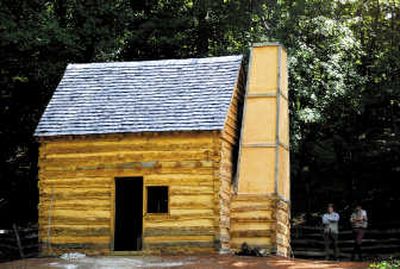Mount Vernon opens exhibit on slave life

WASHINGTON – Joann Bagnerise couldn’t bring herself to visit George Washington’s home at Mount Vernon, driving by without stopping, thinking too much about the hundreds of slaves who had labored in the mansion and fields beyond the brick walls.
Even Wednesday, as she sat in the warm sun near the suburban estate’s new model of a slave cabin, Bagnerise said she was filled with conflicting emotions.
“It’s very solemn,” said Bagnerise, of suburban Dumfries, Va. “I’m feeling all who were enslaved here. I’m just standing on their shoulders.”
On Wednesday, Mount Vernon unveiled its highest-profile slavery exhibit in years, a 16-by-14-foot log cabin modeled on the field hands’ quarters on Washington’s vast estate along the Potomac River in Virginia just south of here. The exhibit is the first to show how the majority of Washington’s slaves lived, Mount Vernon officials said.
In recent years, Mount Vernon – the most visited historic home in the country – has undertaken a pricey effort to renew interest in the life of the nation’s first president, culminating with the opening of a $110 million orientation and museum center last year. Yet officials say visitors have always craved more information about slavery, one of the most troubling aspects of the life of the president and statesman.
“It’s a complex story. His attitudes about slavery changed over time,” said Dennis Pogue, Mount Vernon’s associate director for preservation, who oversaw the slavery project. “It’s not the brightest spot in Washington’s record. But it’s part of his story and America’s story and one that needs to be told.”
Slavery exhibits at historic properties in the Chesapeake Bay region were once rare but are becoming more common, Pogue said. The Jamestown 400th anniversary celebration had African dance troupes, exhibits and speakers. Colonial Williamsburg opened an exhibit on slave life at its Great Hopes Plantation in 2005. Monticello restored the cook’s room next to Thomas Jefferson’s kitchen in 2001 and is considering building a slave cabin; tour guides routinely discuss Jefferson’s alleged paramour, Sally Hemings, who was a slave.
Washington inherited his first slaves when he was 11, records show. But his attitude about the practice, then pervasive on the plantations of Virginia, soured over the years. In 1797 he wrote, “I wish from my soul that the legislature of this State could see a policy of a gradual abolition of slavery.”
On his death, he freed 123 personal slaves.
Mount Vernon, which has 1 million visitors annually, was among the first of Virginia’s historic properties to re-create slave life, depicting it in the brick quarters of the house staff, not far from the elegant white mansion. But more than 200 of the estate’s 316 slaves – many of them women – worked fields of wheat and corn on four nearby farms owned by Washington. The little cabin, made of rough-hewn logs and daubed by mud, is an attempt to show how their families lived, interpreters said.